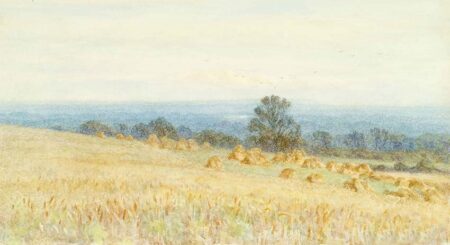Compositional Elements in Painting

A well-executed composition is the backbone of a captivating painting. Compositional elements serve as the building blocks that artists use to arrange and organize various visual elements within a painting. Understanding and harnessing the power of compositional elements can elevate the impact and visual harmony of an artwork. Therefore the placement of subjects and the distribution of lines, shapes, and colors, are important. In this article, we will delve into the world of compositional elements in painting. We will also explore key principles and techniques that artists employ to create compelling and balanced compositions.
Balance
Balance is the distribution of visual weight within a composition. It is achieved by arranging elements in a way that creates a sense of equilibrium. There are three types of balance in art:
- Symmetrical Balance: Achieved when elements are mirrored or repeated on either side of a central axis, creating a sense of stability and harmony.
- Asymmetrical Balance: Involves distributing elements unevenly, but still maintaining a visual balance through the arrangement of different-sized or weighted objects.
- Radial Balance: Created when elements radiate outwards from a central point, often seen in circular or spiraling compositions
Focal Point as a Compositional Element
The focal point is the area or object in a composition that draws the viewer’s attention. Artists strategically position focal points to create visual interest and guide the viewer’s gaze. Techniques for establishing a focal point include:
- Contrast: Utilizing contrasting elements, such as color, value, or size, to make the focal point stand out from the surrounding elements.
- Placement: Positioning the focal point off-center, following the rule of thirds or golden ratio, to create a dynamic and visually pleasing composition.
- Emphasis: Employing techniques such as sharp focus, intricate detailing, or heightened color saturation to draw attention to the focal point.
Lines and Shapes as Compositional Elements
Lines and shapes are fundamental compositional elements that guide the viewer’s eye and create structure within a painting.
- Leading Lines: Lines that direct the viewer’s gaze and lead them through the composition. They can be straight, curved, or diagonal, creating a sense of movement and flow.
- Geometric Shapes: Utilizing geometric shapes, such as squares, circles, or triangles, to create structure, balance, and visual interest.
- Organic Shapes: Incorporating irregular, natural shapes to evoke a sense of fluidity, randomness, or organic growth
Depth and Perspective
Creating a sense of depth and perspective enhances the three-dimensionality of a painting, making it visually engaging and realistic.
- Overlapping: Overlapping objects to indicate spatial relationships and depth.
- Size and Scale: Depicting objects or figures of different sizes to convey distance and perspective.
- Atmospheric Perspective: Using changes in color, value, and detail to depict depth and distance. Distant objects appear lighter, less detailed, and with cooler colors.
Color and Light as Compositional Elements
Color and light play a significant role in setting the mood, atmosphere, and visual impact of a painting.
- Color Harmony: Employing a harmonious color scheme, such as complementary or analogous colors, to create visual cohesion and evoke specific emotions.
- Contrast: Utilizing contrasting colors, values, or intensities to create visual interest and emphasize focal points.
- Light and Shadow: Understanding the play of light and shadow to create depth, volume, and a sense of realism in a painting. Effective use of highlights and shadows can enhance the three-dimensionality of objects.
It can thus be concluded that compositional elements are the artistic tools that painters utilize to organize visual elements and establish balance in a painting.


